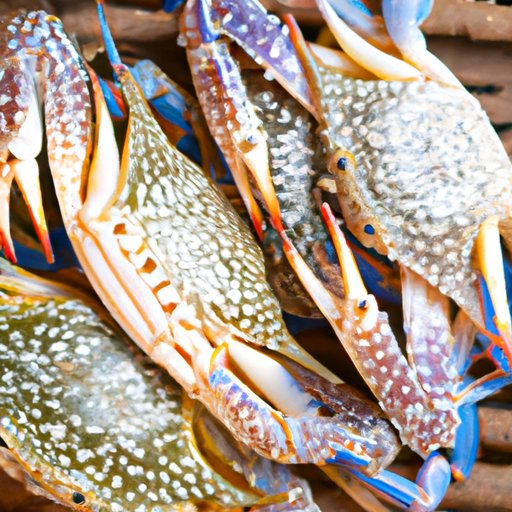Introduction
Blue crabs are a beloved seafood staple in many regional cuisines, especially in areas of the United States such as Maryland and the South. Eating blue crab is an experience that can be both delicious and fun, but can also be a bit intimidating if you’re not familiar with the process. That’s why we’ve created this step-by-step guide to eating blue crab, complete with tips for choosing and cooking the perfect crab, as well as suggestions for pairings and sides, regional delicacies, health benefits, unique recipes, and sustainability concerns.
Step-by-Step Guide to Eating Blue Crab
Before you can start enjoying your blue crab, you need to know how to properly crack and remove the meat. Here’s a step-by-step guide:
Preparation
When choosing blue crab, look for ones that are alive and active, as well as those that meet the size, weight, and season requirements in your area. When it comes to cooking, you can either steam, boil, or grill your crab. For steaming, place a steamer basket inside a large pot with water and your seasonings (such as Old Bay seasoning), and then add the crab for 20-30 minutes. For boiling, place your crab in a large pot of salted boiling water for around 10 minutes, depending on the size. For grilling, brush your crab with melted butter and place on a medium heat grill for around 5-7 minutes per side.
Cracking the Shell
Once your crab is cooked, it’s time to get cracking! First, lift the apron on the bottom of your crab and remove the gills. Then, using your hands or a tool, such as a crab cracker or scissors, start by cracking open the claws. Next, flip the crab over and using your thumbs, push on the hinge located in the center of the crab’s body to separate it into two halves.
Removing the Meat
Once you’ve cracked open the shell, it’s time to remove the meat. Start with the claws by using a crab cracker or scissors to crack the shells and then carefully extract the meat with a fork. For the legs, twist and pull to remove the entire section and use a fork or your fingers to pull out the meat. For the body, use a spoon or knife to remove the meat from the crevices and pockets, being sure to avoid the cartilage.
Additional Tips
Don’t forget about the tasty meat located in the backfin, a small mound located near the crab’s body. You can also enjoy the crab butter, a yellow substance inside the crab’s shell that is edible and delicious. Finally, don’t let the leftover shells go to waste – they can be used to create a flavorful seafood stock or as a decorative addition to a seafood boil.
Regional Delicacy
Depending on where you’re located, blue crabs could be a significant part of your regional cuisine. In areas such as Maryland, blue crabs are often enjoyed in the form of crab cakes or steamed hard-shell crabs, while in the South, they may be enjoyed boiled and seasoned with Cajun spices. To fully enjoy blue crab in these regions, try pairing them with local favorites such as sweet corn, hush puppies, or coleslaw.
Pairings and Sides
When it comes to pairing blue crab with other foods, your options are virtually endless. Some popular choices include grilled vegetables such as asparagus or bell peppers, starchy sides such as potato salad or macaroni and cheese, and fresh, simple salads such as a cucumber or tomato salad. Don’t forget the essential side of warm, buttery bread to soak up all the delicious juices.
Health Benefits
Not only is blue crab delicious, but it also has several health benefits. It’s high in protein, which is essential for building and repairing tissue in your body. Additionally, it contains beneficial vitamins and minerals such as vitamin B-12 and zinc. To keep your blue crab healthy, try grilling or baking it instead of deep-frying. You can also enjoy it in moderation, as it is high in cholesterol.
Unique Recipes
If you’re looking for a new and exciting way to enjoy blue crab, try out some unique recipes such as crab soup, crab-stuffed mushrooms, or even a blue crab omelet. For those with dietary restrictions, you can easily adapt some of these recipes to meet your needs by substituting ingredients or using low-fat cooking methods such as baking or grilling.
Sustainability and Conservation
As with any seafood, it’s important to be mindful of sustainability and conservation efforts when it comes to consuming blue crab. Look for the “Certified Sustainable Seafood” label and choose crab that is caught using sustainable practices. You can also reduce waste and support sustainable fishing by using all parts of the crab and choosing to cook whole crabs instead of just crab meat.
Conclusion
Eating blue crab can be a fun and delicious experience if you know how to properly prepare and enjoy it. Whether you’re new to crab-eating or a seasoned pro, we hope this guide has provided you with helpful tips and suggestions for enjoying blue crab in a sustainable and healthy way.
